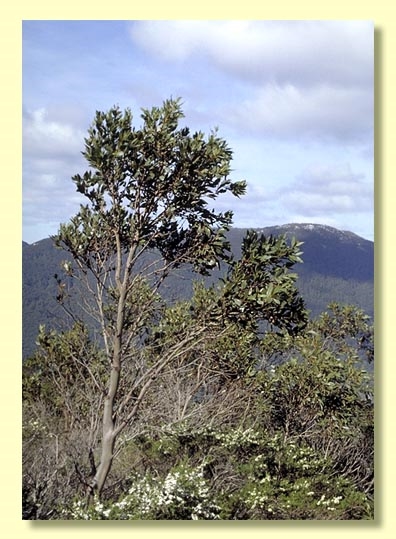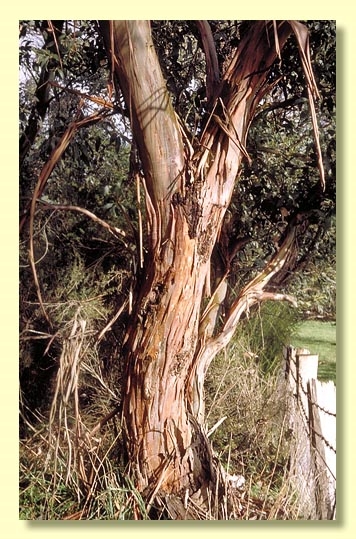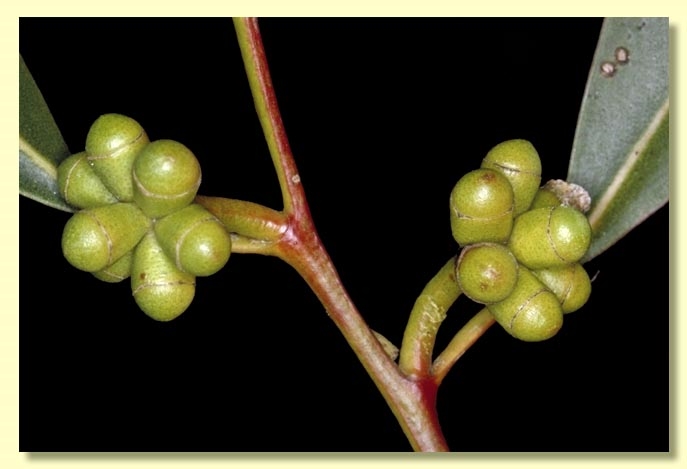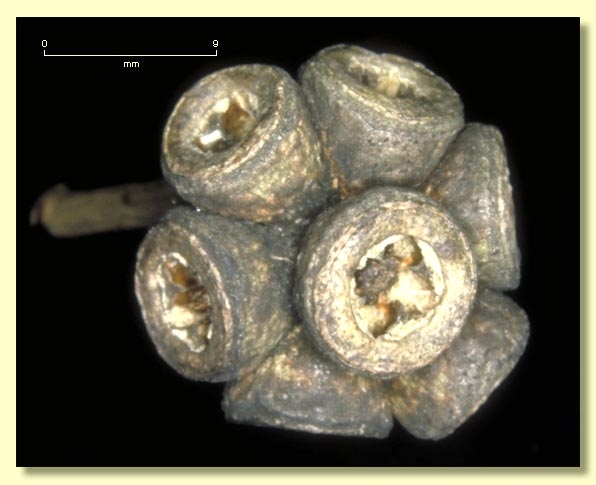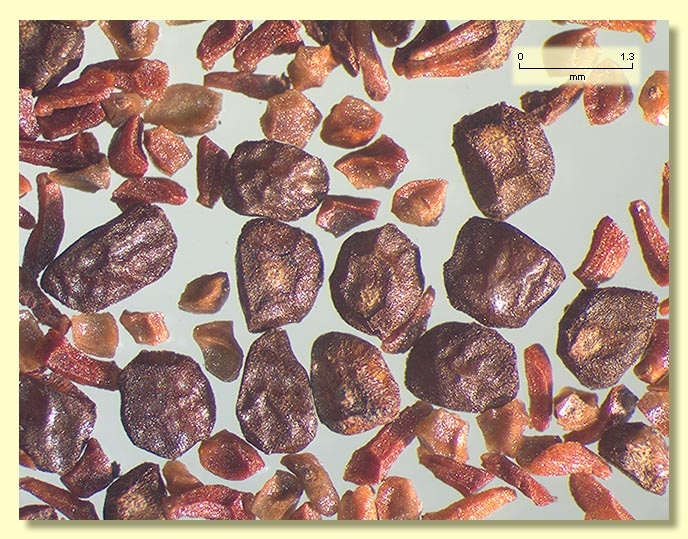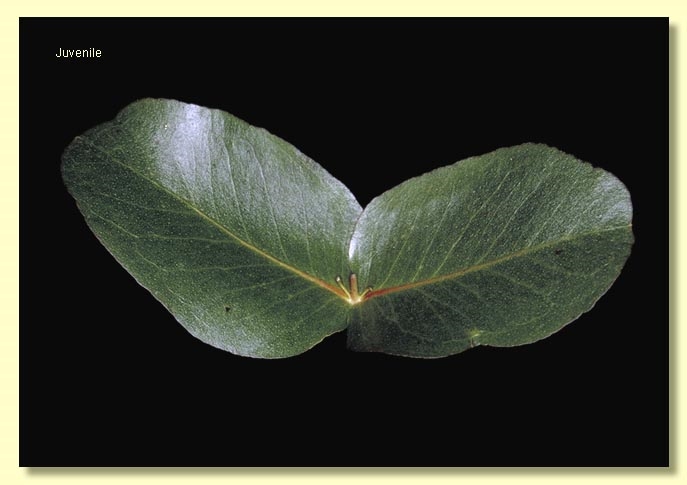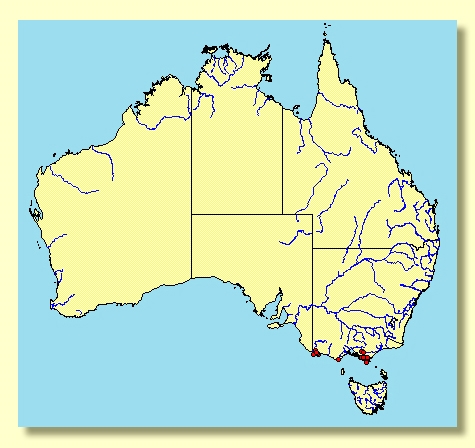Euclid - Online edition
Eucalyptus kitsoniana
Eucalyptus | Symphyomyrtus | Maidenaria | Euryotae | Kitsonianae
Eucalyptus kitsonii Luehm. ex Maiden, Victorian Naturalist 21: 112 (1904) nom. illeg. non Deane (1902). T: Powlett Plains, Vic., 3 Feb. 1903, A.E.Kitson s.n.; holo: NSW.
Bark smooth throughout or with some persistent basal slabs of rough brown bark; smooth bark pale coppery to yellow-green or pink-brown or creamy white, at times with ribbons of decorticated bark in the upper branches.
Juvenile growth (coppice or field seedlings to 50 cm): stem rounded or square in cross section; juvenile leaves opposite and sessile for many pairs, orbicular to ovate, 5–8 cm long, 3.8–6 cm wide, margin crenulate, discolorous, glossy, green.
Crown variably comprising mixtures of juvenile, intermediate and adult leaves. Crown leaves opposite or alternate, sessile or petiolate, petiole 0–2.5 cm long; blade lanceolate to elliptical to ovate, 4.5–20 cm long, 1.5–5.5 cm wide, flat or undulate, base tapering to petiole, concolorous or discolorous, glossy, green, side-veins at an acute or wider angle to midrib, densely reticulate, intramarginal vein parallel to and well removed from margin, oil glands island and intersectional.
Inflorescence axillary unbranched, peduncles 0.5–2.5 cm long, buds 7 per umbel, with conspicuous floral bracts occasionally persisting as buds develop, sessile. Mature buds obovoid to oblong to ovoid, 0.6–0.9 cm long, 0.5–0.6 cm wide, green to yellow, sometimes angled longitudinally, scar present, the outer operculum often remaining on the bud long after abscission, operculum conical to rounded, stamens inflexed or irregularly flexed, anthers cuboid to oblong, versatile, dorsifixed, dehiscing by longitudinal slits (non-confluent), style long, stigma blunt, ovary chambers 3 or 4(5), the placentae each with 4 vertical ovule rows, rarely an incomplete fifth row. Flowers white.
Fruit sessile, cup-shaped, hemispherical, obconical, campanulate or cylindrical, 0.4–0.9 cm long, 0.7–1.1 cm wide, ridged, sometimes slightly angled longitudinally, disc raised-annular, level or descending, 3 or 4(5) valves, near rim level, or enclosed.
Seeds black, brown or grey, 1–2.5 mm long, ovoid or flattened-ovoid, often pointed at one end, occasionally lacunose, dorsal surface smooth or shallowly pitted, hilum ventral.
Cultivated seedlings (measured at ca node 10): cotyledons bilobed to reniform; stems usually square in cross-section; leaves opposite and sessile for many nodes, cordate to elliptical or orbicular, 3–11 cm long, 2.8–8 cm wide, amplexicaul or base truncate to rounded, margin entire or subcrenulate, apex rounded to pointed, dull, grey-green to green.
Flowering has been recorded in January, February, September and December.
A small tree only distantly related to any other eucalypt species and of restricted coastal distribution in Victoria, found in the Welshpool–Foster–Mt Oberon area south-east of Melbourne and Portland district and Apollo Bay areas of western Victoria. Eucalyptus kitsoniana has conspicuous glossy dark green leaves from suborbicular juveniles through to the broadly lanceolate adults. A notable character of E. kitsoniana is the large inflorescence bracts which envelop axillary umbels through their early development, at times persisting until the buds are quite large.
Eucalyptus kitsoniana belongs in Eucalyptus subgenus Symphyomyrtus section Maidenaria, a large group of species more or less restricted to south-eastern Australia, characterised by bilobed cotyledons, simple axillary inflorescences, buds with two opercula, stamens with versatile anthers and flattened seeds with a ventral hilum. Within this section, E. kitsoniana is the only species in series Kitsonianae, having smooth bark, glossy green, sessile, juvenile leaves opposite for many pairs, large inflorescence bracts, small buds in clusters of 7 and small sessile fruit.

